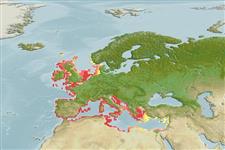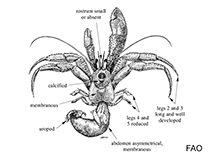Pagurus forbesii Bell, 1845
| Native range | All suitable habitat | Point map | Year 2050 |

|
| This map was computer-generated and has not yet been reviewed. |
| Pagurus forbesii AquaMaps Data sources: GBIF OBIS |
Upload your photos
Google image | No image available for this species;
drawing shows typical species in Paguridae.
Google image | No image available for this species;
drawing shows typical species in Paguridae.
Classification / Names Common names | Synonyms | CoL | ITIS | WoRMS
Malacostraca | Decapoda | Paguridae
Environment: milieu / climate zone / depth range / distribution range Ecology
Benthic; depth range 25 - 35 m (Ref. 97127). Temperate; 62°N - 31°N, 12°W - 37°E
Distribution Countries | FAO areas | Ecosystems | Occurrences | Introductions
Northeast Atlantic and the Mediterranean.
Length at first maturity / Size / Weight / Age
Maturity: Lm ? range ? - ? cm
Minimum depth from Ref. 106185. Occurs in sandy habitats (Ref. 106025). Also found on coralligenous, and detritic bottoms characterized with medium and coarse sands (Ref. 106185). Inhabits many gastropod shells such as those of Cerithium vulgatum, Nassarius incrassatus, Ocenebra aciculata, and Turritella communis (Ref. 105639). In general, pagurids are detritivores (Ref. 107006).
Life cycle and mating behavior Maturity | Reproduction | Spawning | Eggs | Fecundity | Larvae
Members of the order Decapoda are mostly gonochoric. Mating behavior: Precopulatory courtship ritual is common (through olfactory and tactile cues); usually indirect sperm transfer.
Main reference
References | Coordinator | Collaborators
MarineSpecies.org. 2050. (Ref. 3477)
IUCN Red List Status (Ref. 130435)
CITES status (Ref. 108899)
Not Evaluated
CMS (Ref. 116361)
Not Evaluated
Threat to humans
Harmless
Human uses
| FishSource |
Tools
More information
Internet sources
BHL | BOLD Systems | CISTI | DiscoverLife | FAO(Publication : search) | Fishipedia | GenBank (genome, nucleotide) | GloBI | Gomexsi | Google Books | Google Scholar | Google | PubMed | Tree of Life | Wikipedia (Go, Search) | Zoological Record
Estimates based on models
Preferred temperature
(Ref. 115969): 8.9 - 13.4, mean 10.5 (based on 36 cells).



